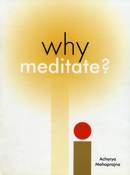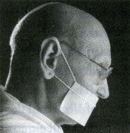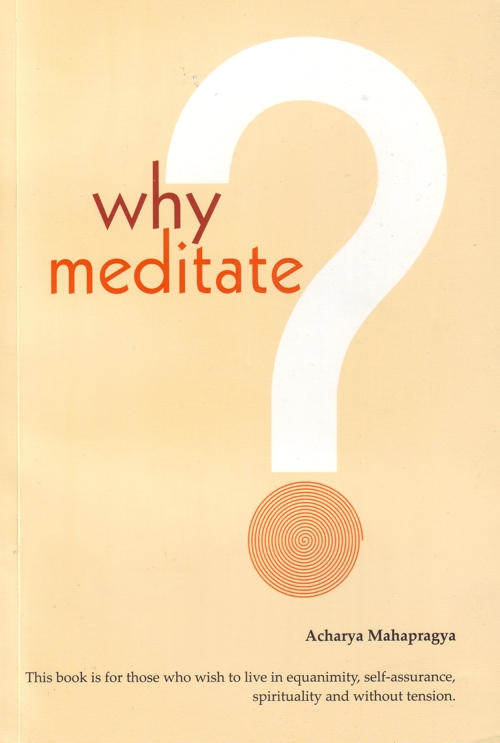
 Prime Minister Chanakya (in King Chandragupta Maurya's court) wrote treatises in economics and politics, in which he described various strategic placements of the troops to besiege the enemy. During battle, the army would array its troops in a particular manner. We, too, in the field of spirituality and religion need some specific kind of strategic arrangement. The 'mohaniya karma' [deluding karma] renders our psyche unconscious or ignorant. It has its own strategic arrangement.
Prime Minister Chanakya (in King Chandragupta Maurya's court) wrote treatises in economics and politics, in which he described various strategic placements of the troops to besiege the enemy. During battle, the army would array its troops in a particular manner. We, too, in the field of spirituality and religion need some specific kind of strategic arrangement. The 'mohaniya karma' [deluding karma] renders our psyche unconscious or ignorant. It has its own strategic arrangement.
The aim of Preksha meditation is to break the array of mohaniya karma and to emerge from its trap. The two elements which besiege our consciousness are the 'feeling of I/ego' and the 'feeling of mine'. These two regulate the array. The entire strategic arrangement is built under the authority of these. 'I am so-and-so' - all these titles belong to the ego.' I am rich, I am a scholar, I am a big officer' - all this is ego. 'My house', 'my family', 'my riches' - all these reflect the 'feelings of mine'. The greater the feelings of ego and 'mine-ness', the more are problems and miseries. If we want to seek the source of misery we will have to reach out to the feelings of ego and 'mine-ness'. Behind these is mohaniya karma.
The feelings of ego and 'mine-ness' create their allies and form their own strategies. Attachment and hatred are born of them. When we are infatuated by someone, attachment develops and the feeling of hatred develops for one we dislike. Attachment and hatred have their own world and they, too, are the creators of their own world. The products of their creations are 'Kashaay' and 'Nokashaay'. Anger, pride, delusion and greed are the creations of attachment and aversion, as also are fear, loathing, lust and sorrow. All are born of attachment and hatred. 'Kashaay' literally means to paint in one's own colours. The hues of 'anger' or 'greed' may imbue one's consciousness and hence render it impure. A coloured glass prevents us from seeing the true colour, and makes the entire world appear to have the colour of that glass. The function of kashaay is to lend a colour to our consciousness. The existence of kashaay ensures instability and activity of the mind, speech and body.
The fundamental principle of Preksha meditation lies in the world of emotions. The system of Preksha meditation is not built upon the mind because the problems related to the mind are secondary; the prime factor is the emotional world. All knowledge depends on the world of emotions. In my opinion, spirituality means to know the world of emotions. He who reaches up to his emotions is spiritual. Mind, speech and body are all structures of the external world, but emotions are internal. This implies that the mind is regulated by emotions, not emotions by the mind. Now let us see the complete sequence of the outcome of emotions: the feeling of ego and 'mine-ness' results in attachment and aversion, which in turn lead to kashaay and nokashaay and finally, to the activity of the mind, speech and body.
Mind, speech and body are the executors of emotions. Emotions are primary, with the active elements being mind, speech and body. Mind is an active object of the outer world. Hence, it should be given importance but only after considering the emotional world. Our entire effort is not just for solving the problems of mind, but primarily for solving our emotional problems. Emotional well being will result in mental as well as physical well being. Contrarily, any disturbance in the emotional system will result in both mental as well as physical illness. This is a totally a new perspective of Preksha meditation, different from the conventional systems of meditation, which lay greater emphasis on the faculty of the mind. Preksha meditation is specifically developed on the basis of emotional well-being. The objective of Preksha meditation is to refine the emotional world.
It is obvious from this maze that the mind is not the foremost consideration. First and foremost are the feelings of ego and 'mine-ness', then come attachment and hatred, and, finally, are kashaay and nokashaaya. All these form our emotional world. The fourth place is taken up by the mind, speech and body and their activities.
We have to clearly understand 'emotions'. 'Emotions' are the vibrations of consciousness coming from within. When a tide of vibrations comes from the inner consciousness, an emotion is created. 'Karma sharir' [the subtlest body made of karmic particles] transmits its vibrations to the 'tejas sharir' [luminous body]. When these subtle vibrations are accessed by the brain, emotions are born. The hypothalamus, a part of the brain, receives these vibrations and transforms them into emotions. These emotions in turn regulate the mind. That is why the main objective of Preksha meditation is the refinement and right use of emotions.
Emotions can be of two kinds: positive and negative. If the vibrations from within are impure, they will result in negative feelings, while positive feelings will be developed if they are pure. Hence, we can see the constant flow of two streams: positive and negative feelings. The mind is both pure as well as impure. Whether or not the mind is good can be found out through the stream of emotions. If the mind is controlled by impure emotions, it becomes negative and if it is controlled by pure emotions, it becomes positive.
Mind does not have any concrete existence of its own. We see the blades of the fan move but do they have the power to move by themselves? No, the electric current flowing through them, when we turn on the switch, gives them the power of motion. Similarly, the mind does not function by itself. The flow of emotions begins and turns on the mind. If it is a stream of positive feelings, then the mind will be occupied in performing good deeds and if the stream is of negative feelings, then the mind will be occupied in performing bad deeds.
Let us try to understand this phenomenon deeply. Along comes a set of impure vibrations. Impure feelings will engage the mind in activities like violence, theft and lies. Even the speech and body will be influenced by them. When a person is actively violent, he binds karmas to himself. Karmas are the cause of the cycle of rebirth. Rebirth will cause the formation of a body and senses. Senses receive information from the external word, and establish contact with the outer world. This gives rise to attachment and aversion, resulting in bondage of karmas and the cycle of rebirth continues. This is the maze of mohaniya karma [deluding karma]. In order to break out of this trap, we have to get hold of the root cause. Without knowing the root cause, we cannot hit upon the right spot. The root cause is emotion. We should resolve to control impure emotions and nurture pure feelings.
 Acharya Mahaprajna
Acharya Mahaprajna
 Copyright by Acharya Mahaprajna ©2005
Copyright by Acharya Mahaprajna ©2005